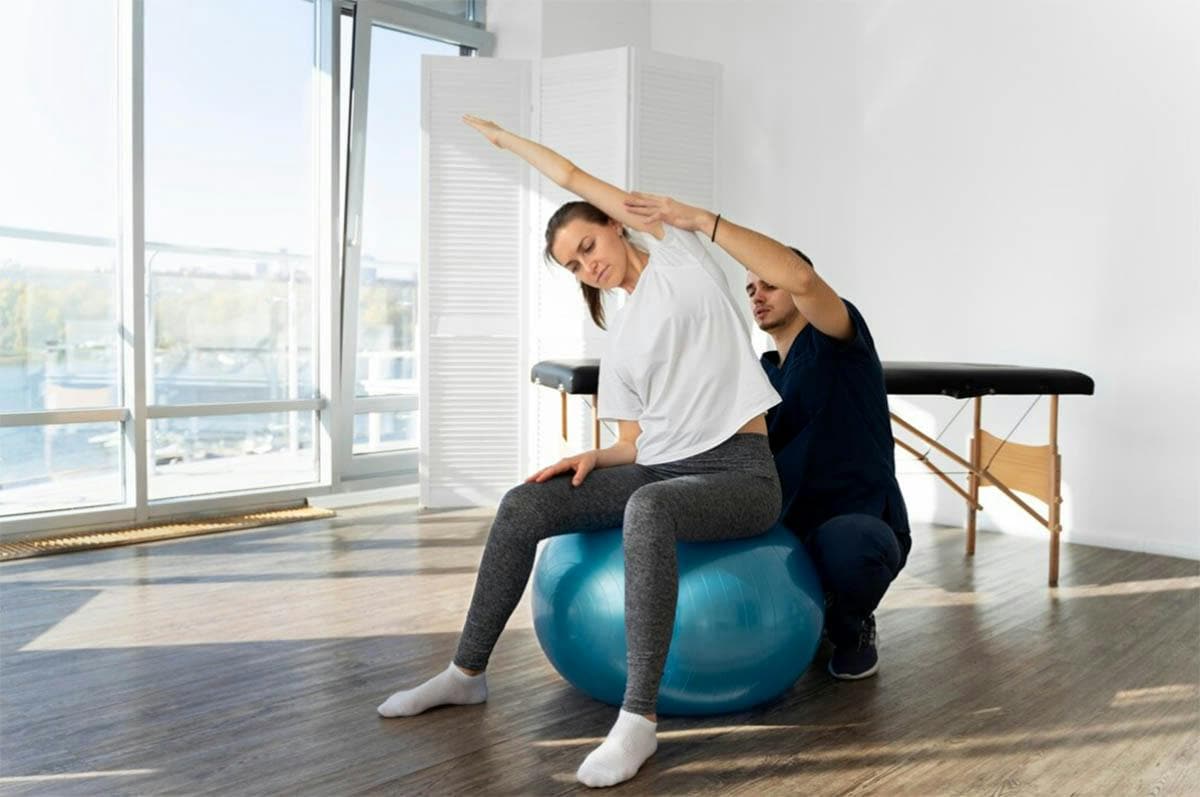Introduction
Lower back pain is a common condition that impacts people of all ages and backgrounds, making physical therapy exercises targeted for lower back pain a crucial aspect of alleviating discomfort. Whether stemming from a sedentary lifestyle, poor posture, or other causes, the discomfort can be challenging to bear.
In this article, we’ll delve into physical therapy for lower back pain, unraveling exercises tailor-made to provide relief.
Why Does My Back Hurt?
Low back pain is a prevalent issue, with around 2.06 million occurrences in a population at risk of over 1.48 billion person-years in the United States. Understanding the reasons behind lower back pain is essential for effective management. Here’s a concise list of common contributors:
Sedentary Lifestyles: Prolonged periods of inactivity and sitting can weaken the supporting muscles of the lower back, leading to discomfort.
Poor Posture: Incorrect posture, whether while sitting or standing, puts undue stress on the spine, contributing to lower back pain over time.
Muscle Imbalances: Weakness or imbalance in certain muscles supporting the spine can lead to improper alignment and strain on the lower back.
Conditions such as Herniated Discs or Sciatica: Structural issues like herniated discs or pressure on the sciatic nerve can result in sharp or chronic lower back pain.
Importance Of Physical Therapy Exercises For Lower Back Pain

The prevalence of low back pain rises with age, peaking around 50–55 years, and continues to increase up to 80 years. Additionally, there is a higher occurrence of low back pain in women.
Due to their multifaceted benefits, low back pain physical exercises are pivotal for managing and preventing lower back pain.
Enhanced Flexibility
Engaging in focused lower back physical therapy exercises promotes an increased range of motion in the muscles and joints around the lower back. This enhanced flexibility helps alleviate stiffness, reduces the risk of injuries, and prevents muscle strain. Incorporating specific aerobic exercises can further contribute to overall back health and well-being.
Strengthened Core Muscles
A key emphasis of these exercises is fortifying the core muscles, specifically targeting the abdominal muscles and those in the lower back. This heightened core strength offers enhanced support to the spine, diminishing strain on the lower back and minimizing the likelihood of recurring pain.
Improved Overall Spinal Health
Physical therapy back exercises, including therapeutic exercises, play a crucial role in enhancing the overall health of the lumbar spine. They promote proper alignment, relieve pressure on vertebral discs, and contribute to a more robust spinal structure, avoiding actions that could make pain worse.
Lasting Relief Over Quick Fixes
Unlike temporary fixes that may exacerbate tight muscles and pain, physical therapy exercises, including targeted activities for extensor muscles, are integral to a comprehensive treatment plan. They address the root causes of lower back pain, prioritizing sustained improvement rather than just symptom management.
Precautions Before Starting Exercises
Before embarking on your exercise routine, consider the following precautions:
Consult with a Healthcare Professional: Choose pain exercises that match your health condition. Tailored physical therapy back exercises support lumbar spine health, proper alignment, and relief from vertebral disc pressure for a stronger spinal structure.
Implement a Proper Warm-up Routine: Incorporate gentle stretches, such as dynamic stretches, to boost flexibility and circulation before beginning the main workout. This ensures a comprehensive approach to your physical therapy routine.
Here are the Best Physical Therapy Exercises for Lower Back Pain

Exercise programs prescribed by physiotherapists have proven effective in alleviating pain for individuals experiencing chronic low back pain. Now have an understanding of the significance of physical therapy exercises let’s dive into specific routines designed to relieve lower back pain.
The following exercises target different aspects of back health, promoting flexibility, strength, and overall well-being.
Cat and Cow Pose
This dynamic duo helps improve flexibility and mobility in the spine. Begin in the starting position on your hands and knees, alternating between arching your back upward (like a cat) and dropping it downward (like a cow).
Cobra Stretch
Lie on your stomach, place both hands under your shoulders, and gently and slowly lift your upper body, arching your back. This stretch specifically targets the stomach muscles, including those near the belly button, promoting relief.
Bird Dog
While on your hands and knees, extend one arm and the left foot simultaneously, holding for a few seconds. This movement engages the core and lower back muscles, promoting increased blood flow for added flexibility and relief.
Prone Leg Lifts
Lying on your stomach, lift one leg at a time, keeping the knee straight. This exercise, supported by a systematic review, specifically targets the leg muscles and strengthens the lower back, promoting improved stability.
Bridge Exercise
The Bridge Exercise is excellent for strengthening the lower back, core, and gluteus maximus. Lie on your back, bend both knees and lift your hips upwards, creating a straight line from shoulders to knees. This movement effectively engages the gluteal muscles.
Pelvic Tilts
Pelvic tilts involve gently rocking the pelvis back and forth while lying on your back. This simple exercise helps improve mobility in the lower back and pelvis, engaging the hip flexor muscles. It’s especially beneficial for relieving muscles tight in these areas.
Knee-to-Chest Stretch
Bring one knee at a time towards your chest, holding it with both hands. This stretch, often recommended for pain patients, is a beneficial form of exercise, alleviating tension in the lower back and enhancing flexibility.
Lower Back Stretch
While seated or standing, reach down towards your toes, keeping your back straight and your foot flat on the ground. Aim for a 90-degree angle with your leg to maximize the effectiveness of this stretching exercise, specifically targeting the lower back muscles.
Spine Stretch
Sitting on the floor with legs extended, reach forward toward your toes. The Spine Stretch, performed in a neutral position, is beneficial for individuals dealing with non-specific low back pain. It promotes flexibility and stretches the lower back.
Side Twists
Seated or lying down, gently twist your torso from side to side. This exercise is particularly helpful for individuals dealing with chronic pain or spinal stenosis, targeting tension in the lower back and promoting spinal flexibility.
Piriformis Stretch
The Piriformis Stretch is a flexibility exercise aimed at the piriformis muscle, known to contribute to lower back pain. Cross one leg over the other and carefully pull the knee towards your chest to relieve tension and enhance flexibility.
Extra Tips to Make Our Back Feel Better
In addition to these exercises, cultivating a healthy lifestyle is crucial for maintaining a healthy back. Pay attention to your posture while sitting and standing, and incorporate ergonomic solutions into your daily activities. Explore various types of exercise therapy to enhance overall well-being, manage pain levels, and promote spinal stability by strengthening spinal muscles.
For Professional Guidance, Consider Consulting Inspire Health PT
While these exercises provide a great starting point, seeking advice from a physical therapy expert can offer personalized guidance. Inspire Health PT specializes in tailoring programs to individual needs, ensuring effective and safe approach to lower back health.
Take the first step towards a healthier back—schedule your consultation with Inspire Health PT today.
Conclusion
Incorporating physical therapy exercises into your health routine can significantly contribute to alleviating and preventing lower back pain. By prioritizing flexibility, strength, and overall spinal health, you empower yourself to lead a more active and pain-free life.
FAQs
Q1: What’s the best exercise for lower back pain?
A1: The ideal exercise varies for each person, but common recommendations include the Cat and Cow Pose, Cobra Stretch, and Knee-to-Chest Stretch. Consulting a physical therapist helps determine exercises tailored to your needs.
Q2: Can exercise fix lower back pain?
A2: While exercise significantly aids in managing and preventing lower back pain by strengthening muscles and improving flexibility, the term “fix” varies. Exercise is vital, but consulting with a healthcare professional is advised for personalized guidance.
Q3: How often should I do physical therapy exercises?
A3: The frequency depends on your condition and prescribed exercises. Start with a moderate routine, gradually increasing intensity. A physical therapist can provide personalized advice based on your health and fitness level.


